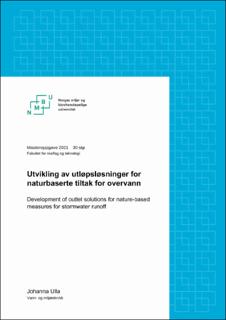| dc.contributor.advisor | Paus, Kim Haukland | |
| dc.contributor.advisor | Nilsen, Vegard | |
| dc.contributor.author | Ulla, Johanna | |
| dc.date.accessioned | 2021-10-19T09:12:18Z | |
| dc.date.available | 2021-10-19T09:12:18Z | |
| dc.date.issued | 2021 | |
| dc.identifier.uri | https://hdl.handle.net/11250/2823822 | |
| dc.description.abstract | Klimaendringer fører til en økning i nedbørhendelser som forsterker behovet for lokal overvannshåndtering. Dette skal oppnås ved bruk av naturbaserte løsninger som skal redusere mengden avrenning på overflaten. For å ivareta naturbaserte prinsipper skal avrenningen oppføre seg i størst mulig grad som i naturen ved bruk av naturbaserte tiltak. Ett av hovedprinsippene innen lokal overvannshåndtering er fordrøyning. Ulike tiltak kan benyttes til dette formålet og et viktig funksjonselement i et fordrøyningsanlegg er mengderegulatoren. Denne plasseres ved utløpet og gir en hydraulisk kontroll på videreført vannføring ut av anlegget. I dagens praksis dimensjoneres normalt magasin med regulator for et nedbørtilfelle med et bestemt gjentaksintervall. Om maksimal videreført vannføring er basert på en natur-situasjon vil magasinet med regulator imitere denne situasjonen for dette gjentaksintervallet. Ved regnhendelser som derimot har et lavere gjentaksintervall vil utløpene kunne bryte med naturbaserte prinsipper ved å videreføre en for stor mengde med avrenning. Dette fordi utløp normalt designes for å redusere magasinstørrelsen samt minimere risiko for gjentetting.
Målet med oppgaven er å finne en utløpsløsning som i størst mulig grad etterligner et naturlig forløp ved både ulike gjentaksintervall og ulik nedbørvarighet. Tre utløpsløsninger ble designet ved bruk av Natural Resources Conservation Services enhetshydrogram-metoden (NRCS). Løsningene ble testet på laboratoriet for å bestemme utløpskoeffisientene. Videre ble funksjonsevnen undersøkt ved bruk av tre ulike nedbør-avløpsmodeller: NRCS, modifiserte rasjonelle metoden (MRM) og Stormwater Management Model (SWMM). Til slutt sammenlignes utløpsløsningen som tilnærmer seg mest et naturlig forløp med virvelkammer som eksempel på utløpsløsning som er effektiv til å videreføre vannføringer ved lave trykkhøyder.
Utløpsløsning 2, som består av et rektangel og et sirkulært utløp ovenfor, ble løsningen som i størst grad etterligner avrenningsforløpet til en natur-situasjon. NRCS og MRM resultatene tyder på at løsningen oppnår et tilnærmet likt forløp som i naturen ved ulike nedbørhendelser. SWMM viste til en økning i forskjell mellom spissavrenningen ved lavere gjentaksintervall. Her ble det tatt hensyn til grunnens infiltrasjonskapasitet i motsetning til de andre nedbør-avløpsmodellene. Resultatene viser at utløpet er overdimensjonert, da spissavrenningen ved de fleste nedbørhendelsene er større enn i naturen. Sammenligning med et virvelkammer viste at utløpsløsningen tilnærmer seg mer et naturlig forløp. Den beste utløpsløsningen er tilnærmet vedlikeholdsfri og består av ingen bevegelige deler som krever jevnlig overvåkning. | en_US |
| dc.description.abstract | Climate change leads to an increase in precipitation events that expand the need for decentralized stormwater runoff management. This is achieved by use of nature-based solutions that reduce the amount of surface runoff. In order to preserve nature-based principals the goal is for runoff to behave as in nature in the best way possible by nature-based measures. One of the main principles within stormwater runoff management is retention. Different measures can be used for this purpose and an important element in every retention basin is the flow regulator. This is placed at the outlet and maintains hydraulic control of the continued flow. In current practice the reservoir with a regulator is dimensioned for a precipitation event with a certain return period. If the maximal continued flow is based on a nature-situation the reservoir with a regulator will imitate this situation for that return period. At precipitation events with shorter return periods the outlet will break with nature-based principles by releasing a too large amount of runoff. This is because the outlet normally is designed to reduce the reservoirs size and minimize the risk of clogging the outlet.
The goal of this study is to find an outlet solution that to the best possible extent imitates the flow of surface runoff in nature for different return periods and different rain durations. Three outlet solutions were designed based on the Natural Resources Conservation Services unit hydrograph method (NRCS). The solutions were tested in the laboratory to determine the outlet coefficient. Further the functionality was examined by use of three precipitation-runoff models: NRCS, modified rational method (MRM) and Stormwater Management Model (SWMM). Finally the outlet solution, which imitates the flow of surface run-off in nature the most, was compared to a vortex chamber as an example for an outlet solution which is effective at giving a continued flow at low pressureheads.
Outlet solution 2, which consists of a rectangular and circular outlet on top, proved to be the solution that imitates a natural flow the most. NRCS and MRM results suggest that the solution almost achieved a natural flow at different precipitation events. SWMM showed an increase in the difference between the maximal amount of runoff at shorter return periods. SWMM takes into account the soils infiltration capacity unlike the other precipitation-runoff models. The results showed that the outlet was designed too big since the maximal amount of runoff at most precipitation events was too large. Comparison with a vortex chamber indicated that the outlet solution approaches runoff in nature the most. The best solution is almost maintenance free and consists of no movable parts which require continued surveillance. | en_US |
| dc.language.iso | nob | en_US |
| dc.publisher | Norwegian University of Life Sciences, Ås | en_US |
| dc.rights | Attribution-NonCommercial-NoDerivatives 4.0 Internasjonal | * |
| dc.rights.uri | http://creativecommons.org/licenses/by-nc-nd/4.0/deed.no | * |
| dc.title | Utvikling av utløpsløsninger for naturbaserte tiltak for overvann | en_US |
| dc.title.alternative | Development of outlet solutions for nature-based measures for stormwater runoff | en_US |
| dc.type | Master thesis | en_US |
| dc.description.localcode | M-VM | en_US |

